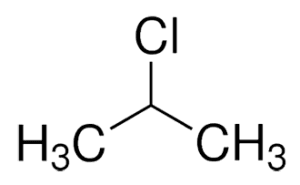Formula C3H7Cl Appearance Colourless liquid | Density 862 kg/m³ | |
 | ||
Isopropyl chloride (also chlorodimethylmethane, 2-propyl chloride, sec-propyl chloride or 2-chloropropane) is a colorless, flammable chemical compound . It has the chemical formula C3H7Cl and is prepared by refluxing isopropyl alcohol with concentrated hydrochloric acid and zinc chloride.
Structurally, isopropyl chloride is an organochlorine compound as well as a secondary (2°) haloalkane, the latter designation identifying the two C-C bonds seen around the carbon atom covalently bonded with the chlorine substituent. To compare, its structural isomer, 1-chloropropane, is instead an example of a primary (1°) haloalkane, as the chlorine-bound carbon atom has only one C-C bond.
As a laboratory reactant, heating 2-chloropropane with alcoholic potassium hydroxide will yield propene (an alkene) by a dehydrohalogenation reaction. However, reacting with potassium hydroxide would compete with an SN2 nucleophilic substitution reaction (minor product) because OH−-ion is a strong, sterically unhindered nucleophile. Because of this, potassium tert-butoxide is one example of a better reagent to use.
